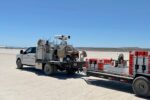At the Association of the United States Army (AUSA) Annual Meeting 2025 in Washington D.C., AimLock and Overland AI unveiled a next-generation unmanned ground vehicle (UGV) that fuses full autonomy with advanced precision targeting capabilities. The joint prototype demonstrates a leap in robotic lethality by combining Overland’s autonomous navigation stack with AimLock’s stabilized fire-control system (FCS), offering a glimpse into future manned-unmanned teaming concepts for dismounted and mounted formations alike.
Fusion of Autonomy and Lethality
The showcased UGV is based on a modified commercial Polaris MRZR Alpha chassis outfitted with an integrated suite of sensors and weapon systems. At its core is Overland AI’s “OverDrive” software stack—an autonomy package designed to enable high-speed off-road navigation without GPS or teleoperation. This is paired with AimLock’s “Precision Engagement Module,” which includes a stabilized mount capable of independently tracking and engaging moving targets using onboard computer vision.
The combined system enables the UGV to autonomously patrol complex environments while detecting threats and executing precision fires without human intervention. According to both companies, this represents one of the first fieldable demonstrations of a fully autonomous lethal ground robot operating under real-world conditions.
Technical Architecture and Capabilities
The prototype features:
- Autonomous Navigation: OverDrive enables terrain-aware path planning using LiDAR, EO/IR sensors, inertial measurement units (IMUs), and machine learning algorithms trained on thousands of off-road driving hours.
- Stabilized Weapon Mount: The AimLock system includes active stabilization for small-caliber weapons (e.g., M240 or M134 Minigun), enabling accurate fire-on-the-move against dynamic targets.
- Computer Vision Targeting: Integrated cameras feed neural networks that classify targets in real-time—distinguishing personnel from vehicles—and cue the weapon system automatically.
- C2 Integration: The vehicle supports Link-16 compatibility and can be remotely tasked via ATAK or other tactical C2 interfaces.
AimLock’s FCS has previously been tested on manned platforms such as helicopters and tripods; this marks its first integration onto an autonomous ground vehicle. The system allows decoupling of sensing from firing—meaning the robot can track multiple targets simultaneously while awaiting human authorization to engage if required by ROE (rules of engagement).
Tactical Use Cases and Operational Concepts
This class of armed UGVs could support numerous missions across conventional and irregular warfare scenarios:
- Dismounted Infantry Support: Operating ahead or alongside squads to suppress enemy positions or scout urban terrain autonomously.
- Perimeter Defense: Patrolling base perimeters or forward operating posts with persistent ISR and automated response capability.
- Manned-Unmanned Teaming (MUM-T): Serving as loyal wingmen for armored vehicles or dismounted patrols while reducing operator cognitive load through onboard autonomy.
The developers emphasized that while the system can operate fully autonomously—including target detection and tracking—rules-of-engagement compliance remains paramount. Human-in-the-loop configurations are supported for kinetic decisions unless pre-authorized under specific mission profiles such as counter-drone defense or perimeter breach scenarios.
AimLock’s Trajectory Toward Robotic Precision Fires
AimLock has steadily advanced its stabilized weapon control systems over the past five years. Its core technology emerged from DARPA research into dismounted precision engagement aids but has since evolved into modular platforms capable of integration across air, land, and sea domains. Notably:
- The company demonstrated helicopter-mounted variants in conjunction with USSOCOM exercises in early FY24.
- A tripod-based variant was evaluated by USMC units for counter-UAS missions in FY23–24 under limited user assessments (LUAs).
This latest integration onto an autonomous UGV reflects growing interest among DoD stakeholders in pairing robotic mobility with scalable lethality—especially as peer threats field increasingly sophisticated unmanned systems themselves.
Overland AI’s Battlefield Autonomy Stack
Seattle-based Overland AI has focused exclusively on off-road autonomy for military applications since its founding in 2021. Its flagship product “OverDrive” was selected by DARPA’s RACER program to power next-gen unmanned combat vehicles navigating at speed through complex terrain without GPS reliance—a critical capability given adversary jamming threats observed in Ukraine and elsewhere.
The company claims over 10,000 km of autonomous testing across varied terrain types including desert scrublands, forests, urban rubble fields, and snow-covered trails. Its software stack leverages reinforcement learning models trained on synthetic environments blended with real-world telemetry data collected during test events at Yuma Proving Ground (YPG) and Fort Irwin NTC.
Pentagon Interest & Future Roadmap
This joint demonstration aligns closely with emerging US Army priorities under its Robotic Combat Vehicle (RCV) program family. While current RCV-Light prototypes remain unarmed during experimentation phases due to ethical concerns around autonomy-lethality coupling, industry partners like AimLock/Overland are helping shape what future armed variants might look like once policy frameworks mature.
No formal program-of-record exists yet for this specific configuration; however, both companies confirmed discussions are underway with Army Futures Command elements exploring potential experimentation pathways through DEVCOM GVSC or Project Convergence events in FY26–27 cycles. Additional interest has been expressed by allied nations seeking modular lethal UGVs for border security roles where persistent ISR paired with rapid response is vital.
Lethal Autonomy Debate Remains Active
The unveiling also reignites debate around lethal autonomous weapons systems (LAWS). While the Pentagon maintains policies requiring meaningful human control over lethal force decisions per DoD Directive 3000.09 (updated Jan 2023), advances like this blur lines between automation levels—especially when latency constraints make real-time human input impractical during close contact engagements or drone swarms attacks.
AimLock representatives emphasized their architecture supports multiple modes—from fully manual to semi-autonomous to supervised autonomy—with clear audit trails for every engagement decision made by either human operator or machine logic tree. Nonetheless, calls persist among academic watchdogs and NGOs urging stricter international governance before such systems proliferate globally without consensus norms on use-of-force thresholds or accountability structures.
Conclusion: A Glimpse Into Robotic Warfare’s Near Future
The AimLock–Overland AI collaboration at AUSA 2025 offers more than just another tech demo—it signals convergence between battlefield robotics maturity and scalable lethality solutions tailored for near-peer conflict environments where speed-of-decision may dictate survival. As doctrinal shifts toward distributed operations accelerate under Multi-Domain Operations (MDO) concepts, platforms like these could become indispensable force multipliers if paired responsibly within ethical frameworks that preserve command accountability while leveraging machine speed advantages where appropriate.










